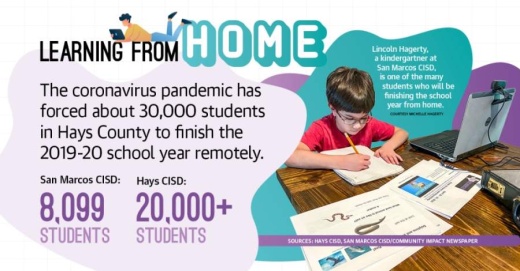The two local districts, after extending spring breaks and moving reopening goals, were directed to close for the remainder of the school year by Gov. Greg Abbott on April 17. It sent administrators, teachers, parents and students scrambling to pilot online education in unprecedented ways.
“A lot of us build our classrooms on relationships and those daily interactions that we take for granted, and that’s one of the hardest things for most of us,” said Michael Strunk, a 12th-grade teacher and coach at San Marcos High School. “Not being able to have those face-to-face interactions with our students and building those personal relationships [is difficult].”
One of the biggest hurdles of remote instruction for Strunk has been balancing new learning material under the present circumstances while “not overloading” his students mentally, he said.
One of the benefits Strunk sees from online instruction is a more “real” connection between him and his students, as he learns more about their “backgrounds” through increased parent communication.
“It’s allowed me to assess the need of our district and kids a little bit better, in what they need, how they learn and how to address those needs,” Strunk said. “They get a little more real with you.”
SMCISD has implemented tools, including Google Classroom, Canvas and Zoom, for teachers and students to maintain communication. Teachers post assignments on a weekly basis on the district website and students submit them weekly. Paper packets with the weekly assignments are also available at San Marcos High School, Goodnight Middle School, and Hernandez, Mendez, Travis, Bowie, and Crockett elementary schools.
The district has also partnered with Tutor.com to provide free online tutoring for students 24/7.
HCISD and SMCISD have altered the way attendance and grades are recorded for students for the rest of the school year.
In both districts, attendance is recorded but is not counted for or against students. Similarly, no hard grades are being given by teachers; online assignments are being counted as complete or incomplete with no grade.
Teachers and parents struggle
Tracy Hartley, a special education teacher at Miller Middle School in SMCISD, said in a statement that distance learning has been difficult for her, as communication with her students is key to her role and remote learning presents new challenges.
“I struggle to get a hold of all of my students and so far there is not a lot of participation, even from those that do have access to technology, Chromebook and WiFi,” Hartley said. “Some of my students don’t have their parents at home with them to keep them on track with their school work —their parents are working—some of them are babysitting their siblings at home.”
Though she’s thankful for the time at home with her family. Hartley said that like most teachers, she’s missing time with her students.
“I absolutely can’t wait till August,” Hartley said.
Area parents are also facing tough times as their children learn digitally at home.
Miranda Marie Hinojosa a parent in SMCISD with a full-time job and three students in school, said online learning has been “overwhelming and mentally stressful.” With children in fourth, eighth and ninth grades, Hinojosa said she tries to balance work, staying healthy, keeping up with her bills and keeping her children on track.
“Having to make sure all three [children] get it all done is tough,” Hinojosa said. “So many places to check, emails, Google Classroom, Canvas, texts coming in left and right for Zoom [meetings], it’s all just overwhelming.”
Though the challenges faced by parents vary, most of them agreed on one thing: teachers are doing the best they can under the circumstances.
“The teachers in our experience have done a really good job at getting assignments, communicating with the parents and the students to know what’s expected and what is coming,” said Brandee Gates, a parent of two at HCISD and an essential worker.
Gates said one of her biggest struggles was making her kids know that they weren’t in a full-time summer schedule, but overall has not been overwhelming by the transition.
“I think they’re excited to go back to school; it has been a struggle for them as well. They miss their friends, they miss the interaction, they miss some of their teachers,” Gates said when asked about her children’s response to the digital transition.
Much like SMCISD, HCISD has also developed weekly assignments that are posted for students online through the district’s website. Programs such as Google Classroom, Zoom and ClassDojo are being used by students to maintain communication with their teachers.
Educators are given the freedom to use the online tools they think are the best fit for their lesson plans or subject, according to faculty and staff members from both districts.
Emily Herrin director of digital learning at HCISD, who led the district through its digital transition, said teachers missed their students and are working hard to make it as easy as possible for their students.
“I still get the feedback of [teachers] missing the face-to-face connection with students [and] being with their students in the classroom,” Herrin said. “[Teachers] have really worked hard to make this environment as home-feeling as possible for students, which is not a surprise.”
Michelle Hagerty, a parent at SMCISD, said one of the biggest challenges is keeping herself and her five children motivated.
Though Hagerty agrees that the district and the teachers are doing the best they can, she does not think online classes have the same e ffect on her kids as face-to-face instruction.
“It will never replace one-on-one learning, I don’t think it ever will,” Hagerty said. “It’s not like homeschooling or online classes. We’re parents, not teachers.”





